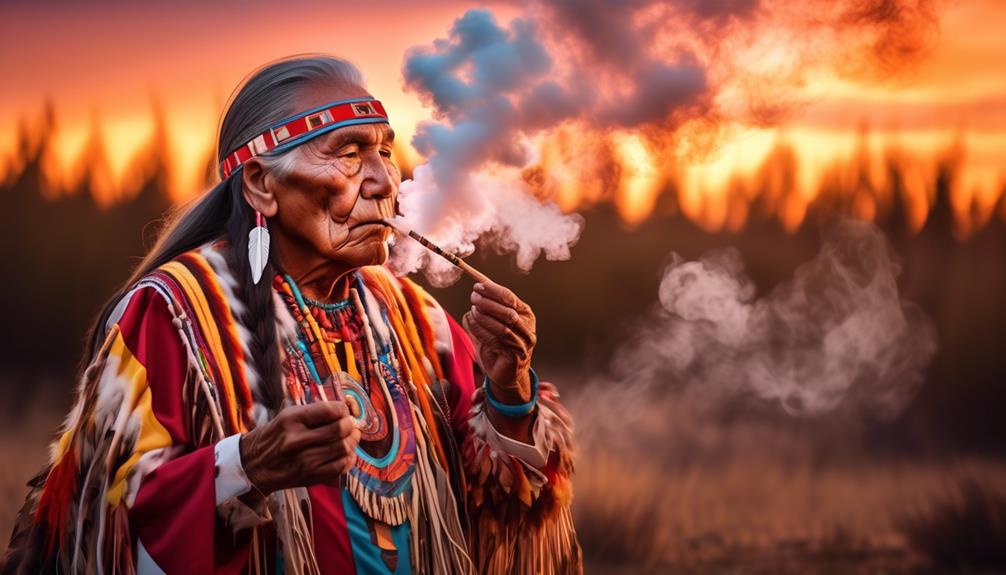
Unveiling the Rich Cultural Significance of Native Smokes
Have you ever wondered about the deep-rooted cultural significance of Native smokes? It’s fascinating to explore the history, traditional uses, and sacred ceremonial practices surrounding these ancient traditions.
From healing and spiritual purposes to their role in indigenous communities, Native smokes hold a wealth of cultural significance.
In this discussion, we will delve into the diverse perspectives on Native smokes, the importance of preserving indigenous traditions, and the respectful practices that honor their cultural heritage.
So, get ready to embark on a journey of discovery and gain a deeper understanding of the rich tapestry woven through the use of Native smokes.
Table of Contents
History of Native Smokes
Throughout history, Native smokes have played a significant role in the cultural practices and traditions of Indigenous communities across the world. The history of Native smokes is deeply intertwined with the concept of traditional harvesting and cultural preservation.

For generations, Indigenous peoples have engaged in the careful cultivation and collection of various plants to create sacred smoking blends. Traditional harvesting techniques have been passed down through oral traditions, ensuring the preservation of cultural knowledge and practices. Indigenous communities have developed a deep understanding of the plants’ medicinal and spiritual properties, selecting specific herbs and tobacco varieties for their unique qualities. This careful selection process reflects the interconnectedness between the natural world and Indigenous cultures.
The act of smoking these sacred blends holds great cultural significance, serving as a means of communication with the spiritual realm and connecting with ancestors. The smoke is believed to carry prayers and messages to higher powers, fostering a sense of unity and belonging within the community.
The preservation of Native smokes is crucial for the continuation of Indigenous cultural practices. It’s a way for Indigenous communities to maintain their traditions, pass down ancestral knowledge, and strengthen their cultural identity. By honoring and respecting the history of Native smokes, Indigenous peoples ensure the preservation of their cultural heritage for future generations.
Related Article: Why Are Native Smokes Sacred Rituals?
Traditional Uses of Native Smokes
Native smokes hold deep cultural significance and are used in various traditional practices. Ritual and ceremony play a vital role in the utilization of native smokes, with their smoke believed to carry prayers and intentions to the spiritual realm.
Additionally, native smokes are known for their healing properties, used to cleanse and purify both individuals and spaces. Through these traditional uses, native smokes serve as a powerful tool in connecting with ancestors, spirits, and the natural world.
Ritual and Ceremony
In the rich tapestry of Native cultural practices, the traditional uses of native smokes hold a profound significance, woven into the fabric of ritual and ceremony. Healing rituals and spiritual customs are deeply intertwined with the act of burning sacred herbs and plants.
The smoke carries prayers and intentions, creating a bridge between the physical and spiritual realms. It’s believed that the aroma of the burning herbs purifies the space and brings balance and harmony to the participants.
The act of smudging, for example, involves the use of a smudge stick made from dried herbs, such as sage or cedar, to cleanse the energy of a person, object, or space. This ritual is often performed during important ceremonies, such as births, weddings, or funerals, to ensure the presence of positive energy and protection.
Native smokes aren’t just tools; they’re gateways to connect with the spiritual realm and honor the ancestral wisdom that has been passed down through generations.
Healing Properties
The sacred act of burning native smokes not only holds deep cultural significance in Native rituals and ceremonies, but it also embodies the intrinsic healing properties passed down through generations.
Native smokes, such as sage, sweetgrass, and cedar, have long been used in healing practices and traditional remedies by Indigenous communities. The smoke produced by these plants is believed to possess purifying and cleansing qualities that can remove negative energies and restore balance to the body, mind, and spirit.
When burned, the aromatic smoke is thought to release medicinal compounds that can alleviate physical ailments, promote emotional well-being, and even provide spiritual guidance. These healing properties aren’t only cherished within Native cultures but are increasingly recognized and embraced by individuals seeking holistic approaches to wellness.
Sacred Ceremonial Practices
In sacred ceremonial practices, Native smokes hold deep ritual significance, serving as a gateway to spiritual connection and ancestral wisdom.
Through the careful observation of traditional customs, these sacred rituals provide a platform for community members to honor their ancestors, seek guidance, and cultivate a profound sense of unity.
The use of Native smokes in these ceremonies underscores the rich cultural heritage and spiritual beliefs of Indigenous communities, offering a powerful means of connecting with the divine.
Ritual Significance
Ritual significance in Native smokes encompasses a rich tapestry of sacred ceremonial practices that are deeply rooted in cultural traditions and beliefs. These ritual practices serve as a way for Native communities to connect with their cultural heritage and maintain a sense of belonging.
The act of smoking in Native rituals isn’t simply a physical action, but a spiritual one as well. It’s believed that the smoke carries prayers and messages to the spirit world, fostering communication with ancestors and other spiritual beings.
Smudging, a common Native smoking ritual, involves the burning of sacred herbs such as sage or sweetgrass to purify and cleanse both individuals and spaces. This ritual significance highlights the importance of Native smokes in maintaining cultural identity and spiritual connection within indigenous communities.
Spiritual Connection
Deeply ingrained in Native cultural traditions and beliefs, sacred ceremonial practices surrounding Native smokes serve as a powerful conduit for spiritual connection.
These practices, often conducted in healing ceremonies, create a profound sense of ancestral connection and belonging.
The act of smudging, for example, involves burning sacred herbs such as sage or cedar to cleanse the energy and bring balance to the individual and the community.
Through the rhythmic motions of lighting the smudge bundle, the smoke carries prayers and intentions to the Creator, fostering a deep spiritual connection.
In these ceremonies, participants are reminded of their place in the larger web of life, connecting with their ancestors and the natural world.
The smokes become a tangible representation of the sacred, offering a profound and transformative experience of spiritual connection.
Traditional Customs
As the sacred ceremonial practices surrounding Native smokes continue to unfold, the rich tapestry of traditional customs emerges, offering a glimpse into the profound spiritual connection experienced by Indigenous communities.
These traditional practices are deeply rooted in the cultural heritage of Native peoples and play a crucial role in their cultural preservation. The customs associated with Native smokes are passed down through generations, serving as a way to honor ancestors and connect with the spiritual realm. Through these practices, Indigenous communities maintain a sense of identity and belonging, preserving the wisdom and teachings of their ancestors.
The rituals and protocols involved in Native smokes are carefully upheld, ensuring that the sacredness and significance of the practice remain intact. By engaging in these traditional customs, Indigenous communities reaffirm their connection to their cultural heritage and strengthen their collective identity.
Healing and Spiritual Purposes
Native smokes hold a profound significance in indigenous cultures, serving as powerful tools for healing and spiritual growth. For centuries, native communities have utilized these sacred plants to address physical, emotional, and spiritual ailments. The act of smoking native herbs isn’t merely a recreational or habitual activity; it’s deeply rooted in ancient healing practices that have been passed down through generations. Native smokes are seen as a form of cultural preservation, connecting individuals to their ancestral traditions and wisdom.
In indigenous cultures, healing is seen as a holistic process that involves the well-being of the body, mind, and spirit. Native smokes play a crucial role in this process, as they’re believed to cleanse and purify the individual on a spiritual level. The smoke is seen as a conduit between the physical and spiritual realms, carrying prayers and intentions to the divine. Through the act of smoking, individuals seek spiritual guidance, clarity, and balance.
The healing properties of different native plants vary across cultures. For example, sage is commonly used for its purifying properties, while sweetgrass is used for its calming and grounding effects. Each plant has its own unique energy and healing properties, and it’s important to approach them with respect and reverence.
In addition to their healing properties, native smokes also serve as tools for spiritual growth and connection. The act of smoking is a sacred ritual that allows individuals to connect with their ancestors, spirits, and higher powers. It’s a time for reflection, meditation, and seeking guidance from the spiritual realm.
Cultural Significance in Indigenous Communities
The cultural significance of native smokes extends beyond their healing and spiritual purposes, encompassing a rich tapestry of traditions and customs within indigenous communities. These smokes hold a deep connection to the past, serving as a vessel for intergenerational teachings and cultural preservation.
Within indigenous communities, the passing down of knowledge from one generation to the next is highly valued. Native smokes play a crucial role in this process, as they’re used in various ceremonies and rituals that transmit cultural teachings. Through the act of preparing and using these smokes, elders impart their wisdom and knowledge to younger members of the community, ensuring the preservation of their cultural heritage.
Furthermore, native smokes serve as a tangible link to the ancestors and the land. The plants used in these smokes are often harvested and prepared in specific ways, following traditional practices that have been passed down for centuries. By engaging in these rituals, indigenous communities forge a connection with their ancestors and the natural world, reinforcing their sense of identity and belonging.
In addition, the cultural significance of native smokes is deeply intertwined with the concept of cultural preservation. Indigenous communities understand the importance of safeguarding their traditions and customs, and native smokes play a vital role in this endeavor. By continuing to use and honor these smokes, indigenous communities ensure that their cultural practices aren’t lost to time and that future generations can continue to experience the richness of their heritage.
Native Smokes and Connection to Nature
Immersed in the natural world, native smokes serve as a conduit for indigenous communities to deepen their connection with the land and its inherent wisdom. The act of smoking sacred herbs, such as tobacco or sage, holds profound spiritual significance for Native peoples. It’s a way to commune with the spirits, ancestors, and the natural elements that make up their environment.
For indigenous communities, the connection to spirituality is intertwined with their connection to nature. Native smokes are seen as a means to communicate with the spiritual realm and seek guidance from the natural forces that surround them. The smoke is believed to carry prayers and intentions, sending them into the universe and connecting individuals with the divine.
Furthermore, the practice of using native smokes is rooted in a deep respect for the environment. Indigenous cultures have always had an intimate relationship with the land, viewing it as a living entity deserving of reverence and protection. The use of natural herbs in smudging ceremonies is a testament to this bond, as it highlights the importance of sustaining the delicate balance between humans and the natural world.
In today’s world, where the environmental impact of human activities is increasingly evident, native smokes serve as a reminder of the need to reconnect with nature and live in harmony with the Earth. By honoring the sacredness of the land through smudging rituals, indigenous communities inspire others to adopt a more sustainable and respectful approach to the environment. The act of using native smokes fosters a sense of belonging not only to a specific culture but also to the larger interconnected web of life on this planet.
Role of Native Smokes in Rituals
How do indigenous communities incorporate native smokes into their rituals, and what role do these sacred herbs play in their spiritual practices?
Native smokes hold great ritual significance and play a crucial role in indigenous spiritual practices. For many indigenous communities, the act of burning sacred herbs is seen as a way to connect with the spiritual realm and establish a deeper connection with the divine. The smoke created by burning these herbs is believed to carry prayers and intentions to the spiritual world, acting as a bridge between the physical and metaphysical realms.
In rituals, native smokes are often used to cleanse and purify both individuals and sacred spaces. This purification process is seen as a way to rid oneself of negative energies and restore spiritual balance. The smoke is believed to carry away any stagnant or harmful energies, allowing for a renewed sense of clarity and harmony.
Furthermore, the aroma of the burning herbs is believed to have a transformative effect on the participants, inducing a meditative state and facilitating spiritual journeys. The scents of these sacred herbs are deeply ingrained in indigenous cultures, and their presence during rituals creates a familiar and comforting atmosphere that enhances the spiritual experience.
In addition to their ritual significance, native smokes also symbolize the interconnectedness of all living beings. Indigenous communities often view these herbs as gifts from the Earth, acknowledging the sacredness of nature and the importance of maintaining a harmonious relationship with the natural world.
Incorporating native smokes into rituals is a powerful way for indigenous communities to honor their ancestral traditions, strengthen their spiritual connection, and foster a sense of belonging to their cultural heritage. Through the ritualistic use of these sacred herbs, indigenous individuals are able to tap into their spiritual roots, seek guidance from the divine, and find solace in their shared rituals and beliefs.
Indigenous Knowledge and Wisdom
What valuable knowledge and wisdom do indigenous communities possess, and how is it passed down through generations?
Indigenous communities possess a wealth of traditional practices and indigenous spirituality that form the foundation of their knowledge and wisdom. These practices and spirituality are deeply intertwined with their cultural identity and worldview. They provide a framework for understanding the natural world, the interconnectedness of all living beings, and the importance of maintaining harmony with the environment.
Indigenous knowledge is often passed down through oral traditions, storytelling, and experiential learning. Elders play a crucial role in this transmission, as they hold the wisdom and accumulated knowledge of their ancestors. Through their teachings, they impart valuable lessons about the natural world, sustainable practices, and the importance of community and kinship.
Traditional practices also serve as a means of preserving and transmitting indigenous knowledge. These practices, such as ceremonies, rituals, and sacred dances, are deeply rooted in indigenous spirituality. They provide a space for connection with the spiritual realm, ancestors, and the land. Through participation in these practices, individuals not only gain knowledge but also develop a deep spiritual connection with their heritage and cultural identity.
Symbolism and Symbolic Meanings
As you delve deeper into the rich cultural significance of Native smokes, it becomes apparent that symbolism and symbolic meanings play a crucial role in indigenous communities. Symbolism in art is a powerful tool used by Native Americans to express their deep-rooted connection to nature, spirituality, and the ancestral knowledge passed down through generations. Indigenous communities hold a strong belief in the interconnectedness of all living beings, and this is reflected in their artistic expressions. Through intricate patterns, colors, and motifs, Native American art embodies the sacredness of their traditions and serves as a visual representation of their cultural identity.
Symbolic meanings embedded in Native smokes are essential for cultural preservation. The act of smoking isn’t merely a physical act but a spiritual one, bridging the gap between the physical and spiritual realms. Each plant used in smudging holds its own symbolic meaning, such as sage representing purification and cedar symbolizing protection. The smoke itself is seen as a conduit for prayers and intentions, carrying them to the spirit world. This symbolism is passed down from elders to younger generations, preserving the traditional practices and ensuring that the cultural significance isn’t lost.
Understanding and appreciating the symbolism and symbolic meanings in Native smokes is crucial for fostering a sense of belonging and respect within indigenous communities. By acknowledging and honoring these cultural practices, we can help preserve their rich heritage and contribute to the ongoing cultural revitalization efforts.
Native Smokes as a Tool for Communication
Native smokes serve as a powerful means of communication within indigenous communities, conveying messages, intentions, and prayers through the sacred act of smoking. It’s a tool for healing and traditional communication that has been passed down through generations, connecting individuals and communities in profound ways.
In indigenous cultures, smoking native plants isn’t just a physical act; it’s a spiritual practice that holds deep cultural significance. When individuals come together to share a smoke, they create a space for open dialogue, understanding, and connection. The smoke carries their thoughts, emotions, and intentions, allowing them to be heard by the spiritual realm and by each other.
This traditional form of communication is rooted in the belief that the smoke carries prayers and messages to the Creator, acting as a conduit between the physical and spiritual worlds. It’s a way for individuals to express gratitude, seek guidance, and ask for healing. Through the act of smoking, they’re able to release their intentions into the universe, trusting that they’ll be heard and answered.
Native smokes also serve as a tool for healing, as the smoke is believed to cleanse and purify the body, mind, and spirit. It’s used in ceremonies and rituals to clear negative energy, promote balance, and restore harmony within oneself and the community. The act of smoking becomes a form of self-care and spiritual rejuvenation, helping individuals find inner peace and connection to their ancestral roots.
Contemporary Perspectives on Native Smokes
As you explore contemporary perspectives on Native smokes, you’ll notice that modern perceptions of these traditional practices vary widely.
Some individuals view Native smokes as an important cultural symbol, recognizing their deep-rooted significance in Native American communities.
Others, however, may hold changing attitudes towards tradition, questioning the relevance and appropriateness of these practices in today’s society.
Understanding these diverse viewpoints is crucial in appreciating the evolving role of Native smokes and their continued cultural significance in the present day.
Modern Perceptions of Native Smokes
Contemporary perspectives on Native smokes reveal a complex and evolving understanding of their cultural significance and societal impact. Modern perceptions and changing attitudes towards Native smokes reflect a shift in society’s awareness of indigenous traditions and the importance of cultural preservation.
Native smokes are no longer solely viewed as a harmful habit or a symbol of addiction, but rather as a means of connecting with ancestral roots and reclaiming indigenous identity. This shift in perception is driven by a growing recognition of the historical injustices faced by indigenous communities and a desire to honor and respect their cultural practices.
As more individuals seek to understand and appreciate the rich cultural significance of Native smokes, they become active participants in the process of cultural revitalization and contribute to the preservation of indigenous knowledge and traditions.
Cultural Significance Today
With a deep-rooted cultural heritage, Native smokes continue to hold immense significance in the lives of indigenous communities today. The act of smoking traditional tobacco carries a strong sense of cultural preservation, as it represents a connection to ancestral traditions and values.
Native smokes serve as a powerful symbol of cultural identity, reinforcing a shared sense of belonging within indigenous communities. Through the act of smoking, individuals honor their ancestors, pay tribute to the natural world, and strengthen their spiritual connection to the land.
The use of Native smokes also serves as a means of resistance against the historical and ongoing marginalization of indigenous peoples. It’s a way of reclaiming and asserting cultural autonomy, reaffirming the importance of indigenous traditions in the face of pervasive assimilation pressures.
Changing Attitudes Towards Tradition
Changing attitudes towards tradition in contemporary perspectives on Native smokes reflect a complex interplay between cultural preservation and adaptation.
As the world becomes more interconnected, Native communities find themselves navigating a delicate balance between holding onto their cultural heritage and embracing the changes brought by modernity.
For some, the act of smoking traditional tobacco holds deep spiritual and ceremonial significance, serving as a connection to ancestors and a way to honor their traditions. However, others may view smoking as a harmful habit and seek to distance themselves from it.
This shift in perspectives can be attributed to various factors, including health concerns, changing societal norms, and external influences.
Nonetheless, cultural preservation remains a priority, as Native communities strive to find ways to adapt their traditions to the evolving world while continuing to honor and pass them down to future generations.
Preserving and Revitalizing Indigenous Traditions
In the effort to preserve and revitalize Indigenous traditions, communities are actively reclaiming their cultural practices and passing them down to future generations. Preservation efforts and cultural revitalization play a crucial role in maintaining the rich cultural heritage of Indigenous peoples. These traditions, deeply rooted in the history and identity of Indigenous communities, provide a sense of belonging and connection to their ancestors and land.
Indigenous communities understand the importance of preserving their traditions and are taking proactive steps to ensure their survival. Elders and community leaders play a vital role in passing down the knowledge and practices to younger generations. Through storytelling, ceremonies, and cultural events, Indigenous communities are revitalizing their traditions and reinforcing their cultural identity.
Preservation efforts also extend to the creation of cultural centers and museums, where artifacts, artwork, and traditional practices are showcased and celebrated. These spaces serve as a hub for cultural exchange and education, allowing both Indigenous and non-Indigenous people to learn and appreciate the rich tapestry of Indigenous traditions.
Additionally, collaborations between Indigenous communities and academic institutions are fostering research and documentation of Indigenous knowledge systems. This partnership ensures that traditional practices aren’t only preserved but also studied and valued for their contributions to various fields.
Respectful Practices and Cultural Appropriation
As Indigenous communities work towards preserving and revitalizing their traditions, it’s important to address the issue of respectful practices and cultural appropriation. Cultural appropriation refers to the adoption or use of elements from another culture without understanding or respecting its cultural significance.
When it comes to Native smokes, it’s crucial to approach this practice with ethical considerations and respect for Indigenous cultures. Native smokes hold deep cultural significance for many Indigenous communities. They aren’t just products to be consumed, but rather a sacred and ceremonial practice that connects individuals to their ancestors, the land, and the spiritual realm.
Engaging in the use of Native smokes without proper understanding and respect can be seen as a form of cultural appropriation. To ensure respectful practices, it’s essential to seek permission and guidance from the appropriate Indigenous communities before engaging in the use of Native smokes. This demonstrates a commitment to learning and understanding the cultural significance behind this practice.
It’s also important to approach Native smokes with reverence and mindfulness, recognizing the spiritual and ceremonial aspects involved.
Embracing the Diversity of Native Smokes
Embracing the diverse array of Native smokes unveils a rich tapestry of cultural traditions and spiritual practices among Indigenous communities. Native smokes encompass a wide range of plants, each with its unique significance and purpose. Exploring the diversity of these smokes invites us to appreciate the depth of Indigenous knowledge and the interconnectedness between nature, ceremony, and community.
Native smokes aren’t solely for personal enjoyment; they hold deep cultural and spiritual significance. Each smoke carries its own story, passed down through generations, reflecting the unique history and traditions of Indigenous peoples. By embracing this diversity, we can begin to appreciate the complexity and beauty of Indigenous cultures.
Through the exploration of different Native smokes, we gain insights into the values and beliefs of Indigenous communities. We learn about the plants used, the rituals associated with their preparation and use, and the customs and traditions that guide their consumption. This knowledge allows us to engage in cultural appreciation, fostering understanding and respect for the diverse practices and perspectives of Indigenous peoples.
Frequently Asked Questions
Are There Any Health Risks Associated With Using Native Smokes?
Using native smokes can have potential health risks. It is important to understand the impact on respiratory health. Exploring these risks can help us make informed decisions while respecting the rich cultural significance of native smokes.
How Have Traditional Uses of Native Smokes Evolved Over Time?
Over time, the traditional uses of native smokes have evolved through cultural adaptations and the evolution of practices. These changes reflect the rich history and significance of native smokes in various indigenous communities.
Are There Different Types of Native Smokes Used in Different Indigenous Communities?
There are indeed different types of native smokes used in various indigenous communities. These smokes are deeply rooted in cultural practices and rituals, reflecting the rich diversity and traditions of each community.
How Do Indigenous Communities Pass Down Knowledge About Native Smokes to Future Generations?
To pass down knowledge about native smokes, indigenous communities rely on the transmission of Indigenous knowledge. This cultural preservation ensures that future generations understand the rich significance of native smokes and can continue the traditions.
What Are Some Ways Individuals Can Respectfully Engage With and Appreciate the Cultural Significance of Native Smokes Without Appropriating Indigenous Traditions?
To respectfully engage with and appreciate the cultural significance of native smokes without appropriating indigenous traditions, you can start by learning from indigenous communities and their practices. Respectful cultural appreciation is crucial in fostering understanding and honoring their rich heritage.






Leave a Reply